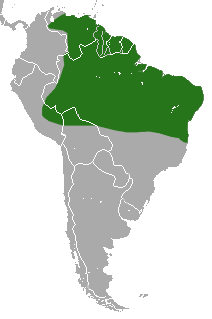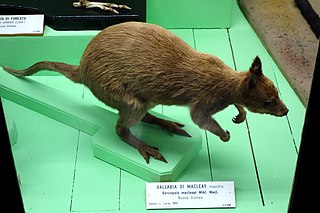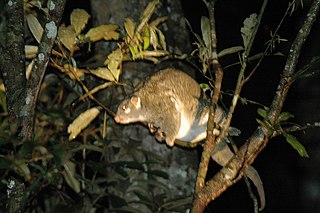
The woolly mouse opossum or long-furred woolly mouse opossum, known locally as the cuíca, is a South American marsupial of the family Didelphidae. Its range includes central Colombia, Venezuela, French Guiana, Guyana, Suriname, eastern Peru, northern Bolivia, and northern Brazil. It was formerly assigned to the genus Micoureus, which was made a subgenus of Marmosa in 2009.

Lontra is a genus of otters from the Americas.

Hylomys is a small genus of the family Erinaceidae. Hylomys species, like all species in the subfamily Galericinae, are known as gymnures or moonrats. Their closest relatives include the fossil Lantanotherium and Thaiagymnura and the living Neotetracus and Neohylomys. Members of this genus are found in Southeast Asia and Eastern Asia.

The prehensile-tailed porcupines or coendous are found in Central and South America. Two other formerly recognized Neotropical tree porcupine genera, Echinoprocta and Sphiggurus, have been subsumed into Coendou, since Sphiggurus was shown by genetic studies to be polyphyletic, while Echinoprocta nested within Coendou.
The silver dik-dik is a small antelope found in low, dense thickets along the southeastern coast of Somalia and in Acacia-Commiphora bushland in the Shebelle Valley in southeastern Ethiopia. It is the smallest species of dik-dik, with a length of 45–50 cm (18–20 in), a height of 30–33 cm (12–13 in), and a weight of 2–3 kg (4.4–6.6 lb). Its back and flanks are grizzled silvery, while the limbs, ears, and muzzle are ochraceus in colour. Little is known about its status, but numbers are believed to be decreasing.

Brachylagus is a genus of lagomorph that contains the smallest living leporid, the pygmy rabbit. One extinct species, Brachylagus coloradoensis, is also known.

Suncus is a genus of shrews in the family Soricidae.
The eastern false pipistrelle is a vespertilionid bat that occurs in eastern and south-eastern Australia, including the island of Tasmania.
Geoxus is a genus of South American rodents in the tribe Abrotrichini of family Cricetidae. Two species—Geoxus valdivianus and Geoxus annectens are known.

Nectomys is a genus of rodent in the tribe Oryzomyini of family Cricetidae. It is closely related to Amphinectomys and was formerly considered congeneric with Sigmodontomys. It consists of five species, which are allopatrically distributed across much of South America: Nectomys grandis in montane Colombia; Nectomys palmipes on Trinidad and in nearby Venezuela, Nectomys apicalis in the western margins of the Amazon biome, Nectomys rattus in much of Amazonia, and Nectomys squamipes in the Atlantic Forest of Brazil. These species are generally semiaquatic, are normally found near water, and are commonly called water rats.

Nesoryzomys is a genus of rodent in the tribe Oryzomyini of family Cricetidae, endemic to the Galápagos Islands. Five species have been described, two of them are considered extinct.

Taphozous is a genus of the family Emballonuridae. The wide distribution of the genus includes several regions of Australia, Indonesia, Papua New Guinea and Africa. Taphozous comes from the Greek τάφος, meaning "a tomb". The common names for species include variants on sac-winged, sheathtail, or tomb bats.

Dorcopsulus is a genus of small marsupials in the family Macropodidae, known as forest wallabies. They are native to dry forests of New Guinea.

False ringtail possums (Pseudochirops) are members of a genus of marsupial in the family Pseudocheiridae. It contains the following species:

Megaderma is a genus of bat in the family Megadermatidae. It contains two living species:

Asian mole shrews (Anourosorex) are a genus of shrews that resemble moles, from China, Taiwan, India, and Indochina. They are the only known genus of the Anourosoricini tribe of red-toothed shrews. The four known species are:

Dama is a genus of deer in the subfamily Cervinae, commonly referred to as fallow deer.















